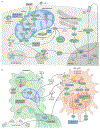Mitochondrial DNA in innate immune responses and inflammatory pathology
- PMID: 28393922
- PMCID: PMC7289178
- DOI: 10.1038/nri.2017.21
Mitochondrial DNA in innate immune responses and inflammatory pathology
Abstract
Mitochondrial DNA (mtDNA) - which is well known for its role in oxidative phosphorylation and maternally inherited mitochondrial diseases - is increasingly recognized as an agonist of the innate immune system that influences antimicrobial responses and inflammatory pathology. On entering the cytoplasm, extracellular space or circulation, mtDNA can engage multiple pattern-recognition receptors in cell-type- and context-dependent manners to trigger pro-inflammatory and type I interferon responses. Here, we review the expanding research field of mtDNA in innate immune responses to highlight new mechanistic insights and discuss the physiological and pathological relevance of this exciting area of mitochondrial biology.
Conflict of interest statement
Competing interests statement
The authors declare no competing interests.
Figures



References
-
- Shadel GS & Clayton DA Mitochondrial DNA maintenance in vertebrates. Annu. Rev. Biochem 66, 409–435 (1997). - PubMed
Publication types
MeSH terms
Substances
Grants and funding
LinkOut - more resources
Full Text Sources
Other Literature Sources

